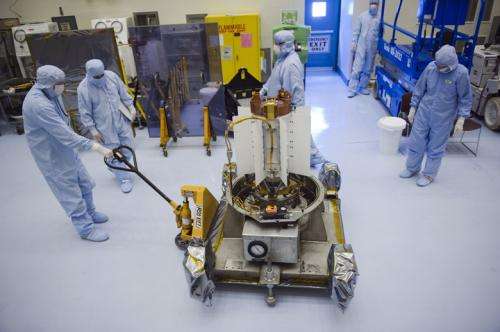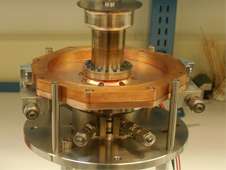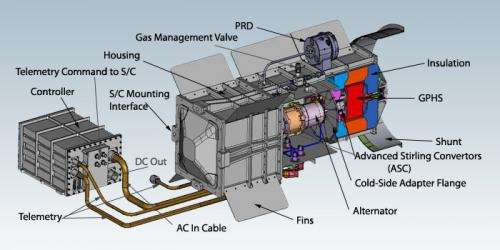NASA halts work on its new nuclear generator for deep space exploration

Another blow was dealt to deep space exploration this past weekend. The announcement comes from Jim Green, NASA's Planetary Science Division Director. The statement outlines some key changes in NASA's radioisotope program, and will have implications for the future exploration of the outer solar system.
We've written about the impending plutonium shortage and what it means for the future of spaceflight, as well as the recent restart of plutonium production. NASA is the only space agency that has conducted missions to the outer planets—even the European Space Agency's Huygens lander had to hitch a ride with Cassini to get to Titan—and plutonium made this exploration possible.
Probably the most troubling aspect of the announcement is the discontinuation of procurement by NASA of flight hardware for what was to be NASA's next generation nuclear power-source for exploration, the Advanced Stirling Radioisotope Generator, or ASRG. This was to replace the Multi-Mission Radioisotope Generator, or MMRTG that has been in use on spacecraft for decades.
The announcement states:

"With an adequate supply of Pu-238… NASA has decided to discontinue procurement of ASRG flight hardware. We have given direction to the Department of Energy… to end work on the flight units. The hardware procured under this activity will be transferred to the Glenn Research Center to continue development and testing of the Stirling technology."
The announcement cites the current budget-constrained environment that NASA and planetary space exploration finds itself up against. What the exact future role is of NASA Glenn beyond basic research and development isn't entirely clear, but two ASRG units that were to be flight-ready for missions in 2016 are shelved for now. The announcement does mention that NASA will continue to utilize flight-proven MMRTG's in the near term, which provide the same approximate power output as the ASRG, albeit with less efficiency.
Plutonium is vital for outer solar system exploration. As you get farther away from the Sun, solar energy ceases to become a viable alternative power source. Pioneers 10 & 11, Voyagers 1 & 2, Galileo, and Cassini all utilized nuclear RTGs, as does the Mars Curiosity rover and New Horizons mission headed out explore Pluto in during its July 2015 flyby. NASA's Juno spacecraft scheduled to reach Jupiter in 2016 will be the first-ever mission without an RTG to explore the outer solar system, and it must employ three enormous solar panels to do so.

And although the production of the Pu-238 isotope used in space exploration was a side-benefit of the Cold War, it isn't the same stuff as its isotopic cousin Pu-239, which is used in nuclear weapons. Plutonium production in the United States ceased in 1989, and although the U.S. government announced earlier this year that NASA will restart the plutonium production pipeline for space exploration, production levels are only expected to reach 1 to 1.5 kilograms per year.
Casey Dreier of the Planetary Society notes in a recent post that:
"The New Horizons mission to Pluto used about 11kg (of Pu-238), which would take anywhere from 7-11 years to generate under the current plan… missions with bigger budgets that could afford regular RTG's will be bottlenecked by the production rate of plutonium to maybe once or twice per decade."
The development of the new ASRG system was to take advantage of NASA and the Department of Energy's remaining supply of plutonium, the exact amount of which is classified but is thought to be enough for perhaps one large Mars Science Laboratory-style mission. (Fun fact: the Pu-238 powering Curiosity was bought from the Russians).
Dr. Stephen Mackwell of the Lunar & Planetary Institute told Universe Today that:
"The ASRG units use around 1.2 kg of Pu-238, while the MMRTG units use around 4.8 kg, both generating around 140 & 125 Watts (at the) beginning of life, respectively. The half-life of Pu-238 is 87.7 years, so the design lifetime can be 14+ years with no problem."
This means that you can get the same output in energy from an ASRG unit using a quarter the amount of plutonium, a much more efficient system than the old MMRTGs. That also would've meant more plutonium to go around for multiple proposed Discovery-class missions, which are missions in the cost range of less than $425 million dollars US.
This definitely spells bad news for any proposed future missions to the outer solar system, such as a dedicated Europa flagship mission or a possible Titan Lakes lander. The proposed Mars 2020 rover which is based on the Curiosity design is probably safe, but may utilize much of what little Pu-238 we've managed to produce at that point.
This may well be the harbinger of things to come, a grim state of outer solar system exploration in the next decade where our "eyes on the outer planets" go dark, one by one. As science journalist Elizabeth Howell noted in an article on Universe Today just yesterday, NASA may be forced to pull the plug on Cassini in the coming year due to budget cuts. It's troubling to think that we're even talking about shutting down a perfectly functioning spacecraft solely due to budget constraints. Plutonium-powered missions give us an enormous bang for the buck: for example, Voyager 2 just passed its 35th anniversary in space last year, and missions such as New Horizons headed outbound from our solar system may well do the same.
But it doesn't have to be this way. Be sure to drop your Congressional representative and the President a line via the Planetary Society's website and let them know that you care about the future of space exploration!
Source: Universe Today





















